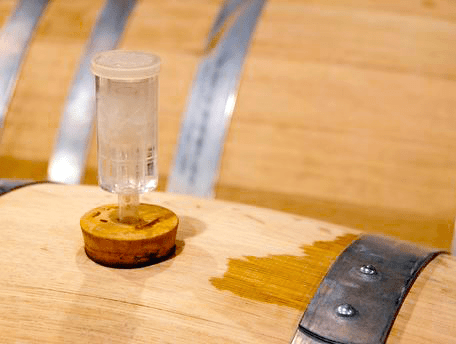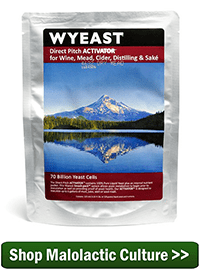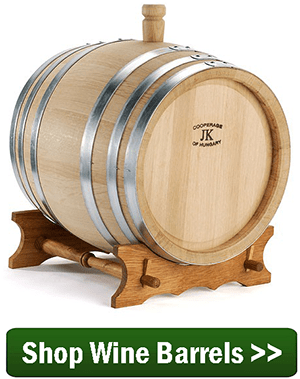 I have a Chilean Pinot Noir from fresh juice. I have a stuck malolactic fermentation. I’ve added malolactic culture when I inoculated my wine… Yesterdays MLF test read 75, pH 3.4, Free SO2 18-28, but my acid was .90%, too High?. Temp is 73 degrees. I’ve added malolactic culture twice. Should I try lowering the acid? Can I add sulfite and move on? Suggestions ? Thanks in advance
I have a Chilean Pinot Noir from fresh juice. I have a stuck malolactic fermentation. I’ve added malolactic culture when I inoculated my wine… Yesterdays MLF test read 75, pH 3.4, Free SO2 18-28, but my acid was .90%, too High?. Temp is 73 degrees. I’ve added malolactic culture twice. Should I try lowering the acid? Can I add sulfite and move on? Suggestions ? Thanks in advance
Name: John F.
State: Mass.
—–
Hello John,
I am assuming that the yeast fermentation has completed and you have an SG in the neighborhood of .996 on your hydrometer.
Going through the numbers, the only thing that concerns me is the SO2 (sulfite) level of the wine. I would rather see it at around 10 to 15 ppm. I’m not saying this is what’s causing the stuck malolactic fermentation, but it very well could be contributing to it. Some experimentation may need to be done with aeration to lower the SO2. This could be as simple as racking the wine in a splashing manner. This alone could be all that is required for restarting your stuck malolactic fermentation.
Dropping some acid out may be helpful, as well, but I do not believe this is the root cause, either. At a total acidity of .90% you need to drop some acid for flavors sake, anyway, so go ahead and start this process to get it down to .80% for now. More readjusting may be needed after the MLF has completely run its course. Lowering the TA could also help with restarting a stuck malolactic fermentation.
The temperature and pH of the wine are fine. I would not be concerned with them at all.
Realize, that an MLF can take months in some cases to finish. It is a function of how much malic acid there is to ferment. Each situation is different. Your malic is currently at 75 ppm, but this does not reflect how much has already been converted into lactic. Is this number lowering over time. That’s what’s important.
If you have not tasted the wine, I would do so now to see if too much lactic acid is starting to form. This will be noted as a sour-tang. If it is too noticeable or forward, then I would add sulfites such as potassium metabisulfite to the wine to stop the MLF and move on. The rest of the excess acid can be reduced with neutralizers such as potassium bicarbonate.
If the wine does not have a forward sour-tang, then wait 3 weeks and take another malic reading. If it has dropped some, then you do not have a stuck malolactic fermentation. Just be patient. The wine will need to age anyway. What’s wrong with it aging while it’s doing its MLF?
As for the malolactic culture, I would not add any more. Too much, could set of an autolysis reaction that can add a bitter-nut to metallic flavor to the wine. This is something that is irreversible.
Restarting a stuck malolactic fermentation is something that very rarely needs to be done. It’s just that sometimes it can progress very slowly with time and patience being the only remedy. I you do have a stuck malolactic fermentation, just remember it is usually because of the environment the fermentation is in and not the lack of malolactic culture.
You can find more information on our website in the article: Malolactic Fermentation.
Happy Winemaking,
Ed Kraus
—–
Ed Kraus is a 3rd generation home brewer/winemaker and has been an owner of E. C. Kraus since 1999. He has been helping individuals make better wine and beer for over 25 years.

I am attempting my first malolactic fermentation. After one month I had noticed very few bubbles in the wine (really only noticed any bubbles if I agitated the carboy) and no activity in the airlock. I re-checked my pH and it remained at 3.2, exactly the same as it was one month ago. I decided that I likely needed to reduce the acidity to get the MLF going. I treated a portion of the wine with Acidex and kept the treated and untreated portions separate for 24 hours. During that time, both treated and untreated started showing activity in the airlock with lots of bubbles in the wine. When I combined them back together, all activity in the airlock and bubbles have stopped. The only difference that I can think of was that I had much more headspace when I separated the treated and untreated samples. SG is 0.990 so I don’t believe it is fermentation from yeast.
what is the proper PH of the water you use in fermentation? I read that reverse osmosis water is not recommend. Thank you.
I do not have a proper pH range of water for you. What I can tell you is that you should be using water that has minerals. These minerals are important for maintaining a vigorous fermentation. Reverse osmosis removes virtually all these minerals. If you do not want to use your straight, tap water, a good second choice would be bottled drinking water. The minerals are balanced in these products and very suitable for adding to a fermentation.